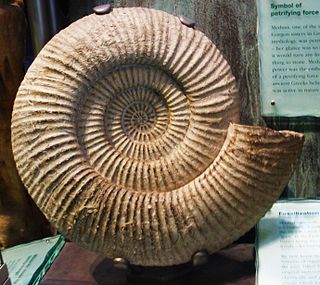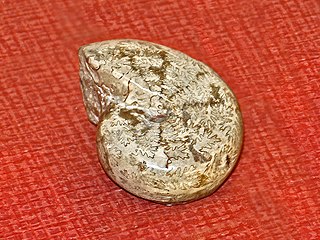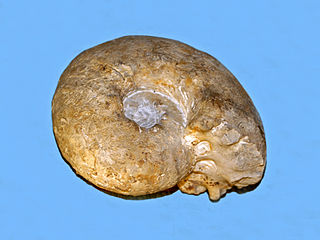
Dactylioceras was a widespread genus of ammonites from the Lower Jurassic period, approximately 180 million years ago (mya).

Ancyloceras is an extinct genus of heteromorph ammonites found throughout the world during the Lower Cretaceous, from the Lower Barremian epoch until the genus extinction during the Lower Aptian.
Arctocephalites is an extinct ammonitic cephalopod genus from the Middle Jurassic with a wide northern distribution belonging to the stephanoceratacean family, Cardioceratidae.

Echioceras is an extinct genus of ammonites from the Early Jurassic of Europe and North America.

Hypophylloceras is a Cretaceous ammonite with a finely ribbed, compressed, involute shell; some having periodic stronger ribs or folds. The suture is complex, with large, asymmetric and finely divided lobes; the 1st lateral being much larger than the external (=ventral) and 2nd lateral lobes. Saddle endings commonly not phylloid.

Calliphylloceras is an ammonite belonging to the Phylloceratidae.

Macroscaphites is an extinct cephalopod genus included in the Ammonoidea that lived during the Barremian and Aptian stages of the Early Cretaceous. Its fossils have been found throughout most of Europe and North Africa.

Calycoceras is an extinct genus of cephalopods belonging to the subclass Ammonoidea and family Acanthoceratidae that lived during the Cenomanian stage of the Late Cretaceous, 100-94 Mya. Their shells had ornate ribs.

Titanites is an extinct ammonite cephalopod genus within the family Dorsoplanitidae, that lived during the late Tithonian of the Late Jurassic. Its fossils have been found in Canada and the United Kingdom.

Cladiscites is an extinct genus of cephalopods in the ammonoid order Ceratitida. These nektonic carnivores lived during the Triassic, from Carnian to Rhaetian age.

Sowerbyceras is a genus of ammonoid cephalopods belonging to the family Phylloceratidae. These nektonic carnivores lived during the Jurassic period, from Oxfordian to Kimmeridgian age.

Phyllopachyceras is an extinct genus of ammonoid cephalopods belonging to the family Phylloceratidae. These nektonic carnivores lived in the Cretaceous, from Hauterivian to Maastrichtian to age.

Protetragonites is an extinct genus of ammonoid cephalopods belonging to the family Lytoceratidae. These fast-moving nektonic carnivores lived from the Jurassic period Tithonian age to the Cretaceous period Aptian age.

Pseudothurmannia is a genus of extinct cephalopods belonging to the subclass Ammonoidea and included in the family Crioceratitidae of the ammonitid superfamily Ancylocerataceae. These fast-moving nektonic carnivores lived in the Cretaceous period, from Hauterivian age to Barremian age.

Orthaspidoceras is an extinct ammonoid cephalopod genus belonging to the family Aspidoceratidae. These nektonic carnivores lived during the Jurassic period, Kimmeridgian age.

Reineckeia is an extinct genus of ammonoid cephalopods belonging to the family Reineckeiidae.

Skirroceras bayleanum is a Stephanoceratacean (ammonite) species belonging to the family Stephanoceratidae.

Skirroceras macrum is a Stephanoceratacean (ammonite) species belonging to the family Stephanoceratidae.

Euaspidoceras perarmatum is an extinct ammonoid cephalopod species that lived during the Jurassic.

Rastellum is an genus of extinct molluscs, which lived from the Middle Jurassic to the Late Cretaceous.




















